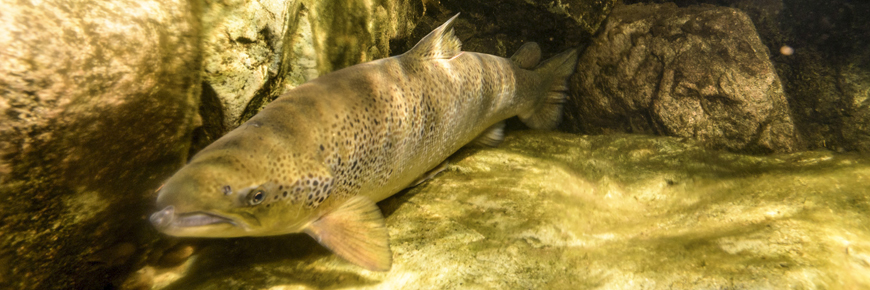
Atlantic salmon
Cape Breton Highlands National Park
The Atlantic salmon is a large, slender fish. When it is in freshwater rivers and streams it is a dark metallic grey. The young salmon, called a parr, has a dark back extending into 8 to 11 stripes down its sides with a red spot between each stripe. Parr and smolts in streams feed mainly on aquatic insect larvae and terrestrial insects. Out at sea, the older fish eat a variety of animals including crustaceans and small fish. Adult salmon returning to freshwater to spawn do not generally feed, although they are willing to take an angler's fly. Atlantic salmon usually live about 9 years in the wild.
Distribution
The Atlantic salmon's range is in the North Atlantic basin from the Arctic Circle to Portugal in the east and from Iceland, southern Greenland and the Ungava Peninsula south to the Connecticut River in the west.
The journey of the salmon
Atlantic salmon are anadromous, which means they generally spawn in freshwater, then go out to sea, returning to freshwater as adults to spawn.
Our Atlantic salmon spawn in October or November, mainly in the Clyburn and Chéticamp Rivers, although there is sometimes an unusual early run in the Chéticamp and Margaree Rivers if rainfall has been heavy. The eggs are laid in a nest in the gravel, called a "redd" and generally develop over the winter, hatching in early spring. Unlike some species of salmon, the Atlantic salmon can live to spawn more than once in a lifetime.
The young salmon live in freshwater for 2 to 3 years before undergoing a physical change called "smoltification" which allows them to tolerate saltwater. At this point the young fish make their journey to sea.
Once in the sea, the young salmon grow very quickly, feeding on the rich panoply of crustaceans and small fish offered by the ocean. Some may return to the rivers of northern Cape Breton to spawn after only one year - these are called grilse, and usually weigh 1 to 3 kilograms. Others stay in the sea for 2 years, returning to the rivers when they weigh 3 to 7 kilograms. Both grilse and adults return to the freshwater streams to begin the spawning cycle anew.
Atlantic salmon are in trouble
Atlantic salmon were caught commercially in gill nets along both coasts of northern Cape Breton for many years. Since the early 1980s, Atlantic salmon have been disappearing from rivers where they were once abundant. The diminishing population may be due to a number of factors, including pollution, habitat destruction and alteration, overfishing and/or disease, to name a few. At least one population of Atlantic salmon has already been listed by COSEWIC as a species at risk. To help preserve the salmon, the commercial fishery was ended in 1984. All the Atlantic salmon you buy in stores these days is salmon from fish farms. Salmon angling continues but in Cape Breton Highlands National Park and much of the northern Cape Breton ecosystem, only catch-and-release fishing of salmon is allowed.
In spite of nearly 20 years of conservation, the Atlantic salmon stocks have not recovered. By-catch of salmon in the course of other commercial fisheries and illegal offshore fishing of salmon may be part of the problem.
At Cape Breton Highlands National Park we monitor returning Atlantic salmon every fall in the Clyburn River. Annual salmon counts allow us to see if populations are increasing or decreasing over the long term.
Further reading
Related links
- Date modified :